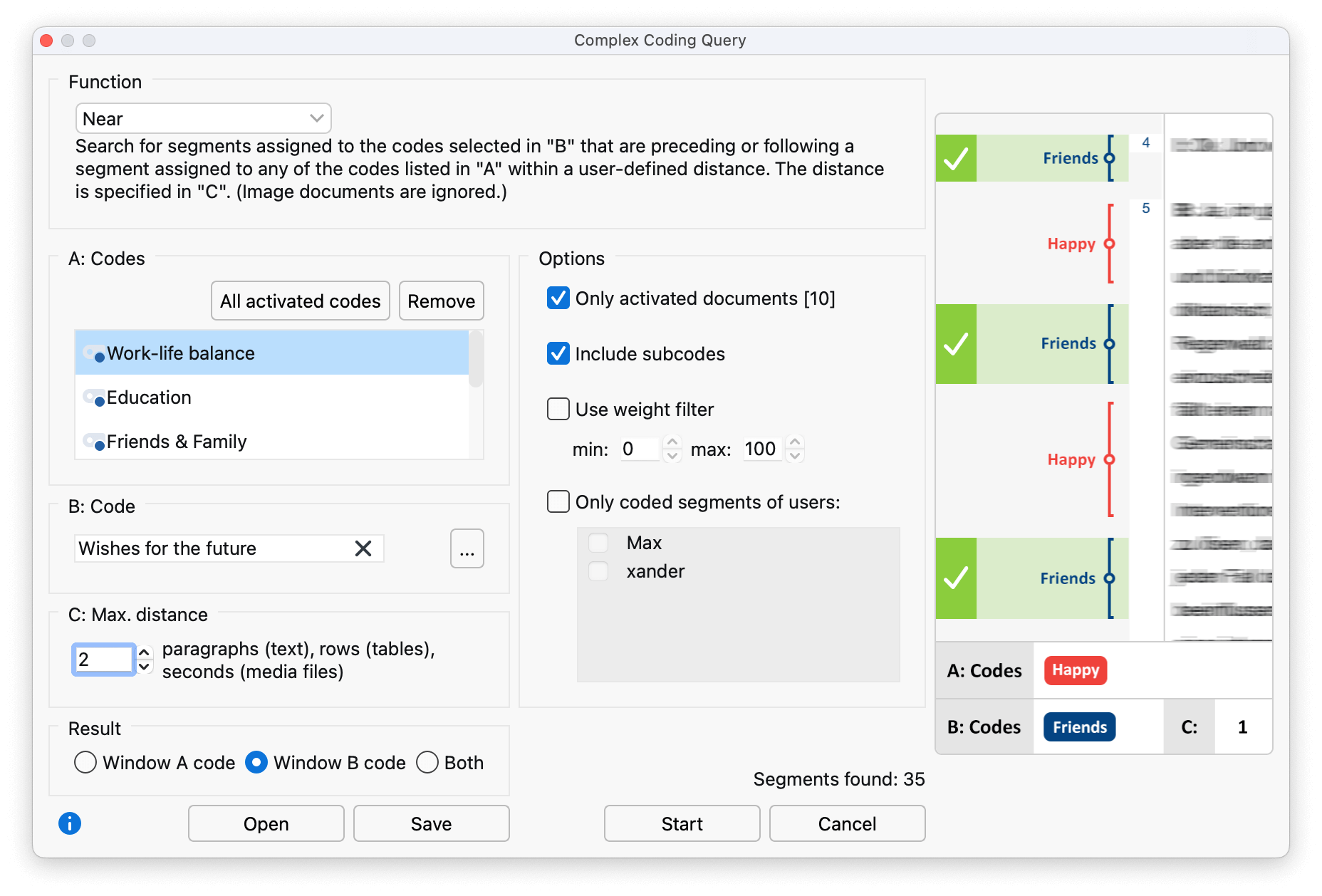By default, the “Retrieved Segments” window shows all segments that are coded with the activated codes in the activated documents. If several codes are activated, they are OR-linked, i.e., it does not matter with which activated code a segment was coded to be listed.
Using the Complex Coding Query instead, you can search for coded segments, while logically combining several codes, for example, outputting only segments where several of the activated codes overlap or where another code has been assigned nearby.
How to run a Complex Coding Query
- Maximize the "Retrieved Segments" window by clicking on its name at the bottom of the screen (if the window is not already open).
- In the menu ribbon, click on Analysis > Complex Coding Query. Alternatively, click on the button Mode: <current query mode>, which is displayed in the "Retrieved Segments" window.
The following dialog window will open:

The dialog window has the following aspects:
- The "Function" field allows you to choose the analysis function, that is, a combination mode of the codes, the operation of which is described in each case.
- Below that, there are three window sections, labeled A, B, and C.
- Section A is needed for every analysis function and holds the selection of codes to be included in the selection function. To add codes, drag and drop them from the Code System window or click on the button All activated codes to include the currently activated code selection in the "Code System" window.
- Section B is needed for some retrieval functions. You can drag and dop only one code into the section. you can do so from the quick list (instead of using drag and drop, you can click on the button with three dots to open a list with last used codes; to transfer a code to the quick list, simply click on it in the "Code System" first).
- Section C allows you to set certain parameters (for example, the maximum distance between two coded segments).
- The "Results" field underneath offer functions to select what should be listed as a result in the "Retrieved Segments".
The "Options" section lets you apply the following settings:
Only activated documents [number of currently activated documents] - the query is limited to the currently activated documents. You can also adjust the activation in the “Document System” when the dialog window is open.
Include subcodes - when this option is activated, not only the selected codes but also their subcodes are taken into account. Think of this option as follows: the codes in the code system are collapsed and all coded segments of the subcodes are included in the coding query. Details on this option can be found in the Include Subcodes in Retrieval section. This option can also be activated in the status toolbar after you have completed your search.
Use weight filter - if the option is activated, only the coded segments whose weight is within the entered range are retrieved. The weight filter can also be set in the status bar after a successful search.
Only coded segments of users - if this option is activated, only the coded segments created by the selected users are taken into account.
At bottom right, you can see how many segments have been found for the current query.
The retrieval begins when you click on the Start button.
The following table gives you an overview of the various analysis functions:
| Name | Description |
|---|---|
| Intersection (”small picture”) | Retrieve only the part segments that have all of the codes listed in "A" assigned to them. |
| Intersection (Set) | Retrieve only the part segments that have at least X of the codes listed in "A" assigned to them (the number X is specified in "C"). |
| Overlapping (”big picture”) | Retrieve the full segments where at least one part has all the codes listed in "A" assigned to it. |
| Only one code | Search for segments where only one of the codes listed in "A" is assigned (and none of the other codes listed in "A"). |
| Only this code | Search for segments where the code selected in "B" is assigned, but none of the codes listed in "A" are assigned. |
| If inside | Search for segments assigned to any one of the codes listed in "A" that are also completely surrounded by a segment assigned to the code selected in "B". |
| If outside | Search for segments assigned to any one of the codes listed in "A" that has no overlap or intersection with a segment assigned to the code selected in "B". |
| Followed by | Search for segments assigned to any one of the codes listed in "A" that is followed by a segment assigned to the code selected in "B" within no more than X paragraphs. The number X is specified in "C". (Does not work in image or PDF documents.) |
| Near | Search for segments assigned to any one of the codes listed in "A" that is preceded or followed by a segment assigned to the code selected in "B" within no more than X paragraphs. The number X is specified in "C". (Does not work in image or PDF documents.) |
You can see which retrieval function is currently active in the top right corner of the "Retrieved Segments" window.

